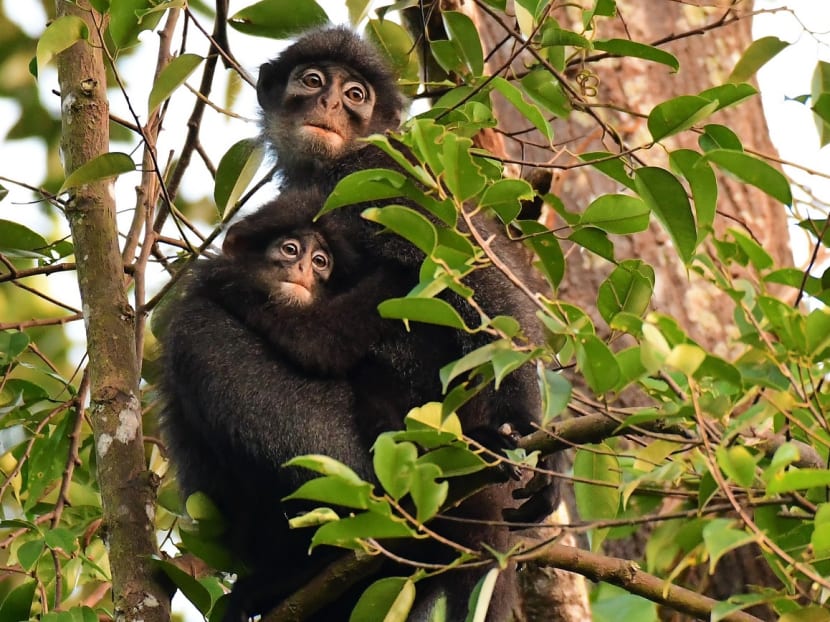Researchers call for protection of SAF training area to preserve feeding ground for Raffles' banded langur
SINGAPORE — A pair of primate researchers in Singapore have called on the authorities to preserve a small forest patch along Upper Thomson Road from further development, as it is one of the feeding grounds for the critically endangered Raffles’ banded langur.

Primatologist Andie Ang said that cutting down the 150ha forest in the state land will remove an important area for the Raffles' banded langurs (pictured) and force them to find a new home range within the remaining forests in the Central Catchment Nature Reserve.
Stay woke: t.me/todayonlinesg

SINGAPORE — A pair of primate researchers in Singapore have called on the authorities to preserve a small forest patch along Upper Thomson Road from further development, as it is one of the feeding grounds for the critically endangered Raffles’ banded langur.
Located just before the Seletar Expressway and opposite the Thomson Nature Park, the forest covers about 150ha or about 210 football fields.
This is equivalent to about 5 per cent of Singapore's largest nature reserve, the Central Catchment Nature Reserve (CCNR).
While this area is state land and is being used by the Singapore Armed Forces (SAF) for training, it is not designated as a protected area for conservation, wrote primatologist Andie Ang and research assistant Sabrina Jabbar in the Lee Kong Chian Natural History Museum’s online journal, Nature In Singapore, on May 19.
Under the Urban Redevelopment Authority’s (URA) 2019 Master Plan, the area is still “subject to detailed planning” for future residential use.
This is a cause for concern for the researchers, as the forested areas along Upper Thomson Road are part of the arboreal primates’ habitat.
‘VITAL FEEDING GROUNDS’
With a small population of around 60, the langurs — which have a body of black fur and white rings around the eyes, and are roughly twice the size of the brown macaques — can be found within the CCNR, the researchers said.
Besides the core areas of the reserve, they said the surrounding buffer forests, such as Windsor Nature Park and Thomson Nature Park, are also “vital feeding grounds” for the langurs.
The researchers said the langurs have also been known to visit the area that they are lobbying to be protected, with eight sightings of the animals since October 2017.
The largest group of langurs there was spotted on the morning of Jan 6 this year.
The researchers said they spotted four adults and a juvenile crossing from the state land forest to Old Upper Thomson Road, where they paused on the edge to “feed on the cream-coloured inflorescences of wild cinnamon”.
“It is, therefore, important that we continue to ensure the long-term protection of these wooded areas.
“This is even more so after the loss of the Tagore/Lentor forest that was adjacent to the state land,” wrote the researchers, referring to the clearance of a 30ha forest in Lentor.
The forest, which was also used by the langurs, was cleared in 2017 to make way for private homes.
Dr Ang, who is a Wildlife Reserves Singapore Conservation Fund scientist, told TODAY that clearing the area in question, where sambar deers can also be found, will remove an important area for the langurs and force them to find a new home range within the remaining forests in the CCNR.
“This is akin to imposing these langurs into existing territories of other groups of langurs in the area, resulting in territorial fights, which can cause injuries and (affect) the stability in social dynamics of existing groups,” she said.

ROPE BRIDGES NEEDED TO KEEP LANGURS SAFE
In response to TODAY’s queries, URA said that in planning the development of Singapore’s land, it works closely with the National Parks Board (NParks) and other agencies to “integrate the retention of our natural and built heritage while meeting development needs”.
Referring to the forest that the researchers are trying to protect, URA said that when detailed plans are drawn up, the developing agency will “undertake the necessary environmental studies” and consult stakeholders as part of the overall planning process for the site.
“The insights obtained will help guide agencies to sensitively plan for the area while integrating core biodiversity areas,” it said.
NParks' group conservation director Adrian Loo said that the agency is part of the Raffles’ Banded Langur Working Group that is chaired by Dr Ang, and will continue to work with her to “strengthen connectivity” for the langurs to cross safely between forest habitats.
Dr Loo said biodiversity surveys have indicated that the langurs frequently move via tree canopies between the CCNR and Thomson Nature Park.
“With this in mind, NParks installed rope bridges across Old Upper Thomson Road to facilitate the safe movement of the Raffles’ banded langur and other arboreal animals,” he said.
Dr Loo said that since the installation of the bridge in August last year, NParks has recorded multiple sightings of the langurs using it.
A second rope bridge was installed earlier this year along this same stretch of road.
Aside from the rope bridges, Dr Loo added that NParks and volunteers also planted plants on which the langurs are known to feed, as part of development works in Thomson Nature Park to enhance their habitat.
Meanwhile, the Ministry of Defence (Mindef) said the SAF worked with NParks last year to install aerial canopy links between the “mentioned SAF training area” and the CCNR. When asked for clarification, a Mindef spokesperson said it was referring to the rope bridge along Old Upper Thomson Road.
While Dr Ang said she was appreciative of the two canopy rope bridges, which showed a “successful collaboration between various stakeholders”, she said such bridges are needed over Upper Thomson Road as well.
The current rope bridges, she said, are built over a single-lane road behind the Thomson Nature Park, while Upper Thomson Road is a six-lane dual carriageway — a precarious journey for the primates.
At least two langurs have been killed by vehicles when they decided to travel on the ground after their usual canopy connectivity was lost when the trees along the road were pruned.
“The langurs have been using the forests on both sides of Upper Thomson Road since many years ago,” she said. “It is part of a core home range of at least one group of langurs that we have been following and studying.”
Dr Ang said that the plight of the langurs is not helped by the construction of the Cross Island MRT Line, which could fragment their habitat.
“It is vitally important that we protect the state land forest for the langurs and other wildlife, especially in light of other developments in the vicinity,” she said.








